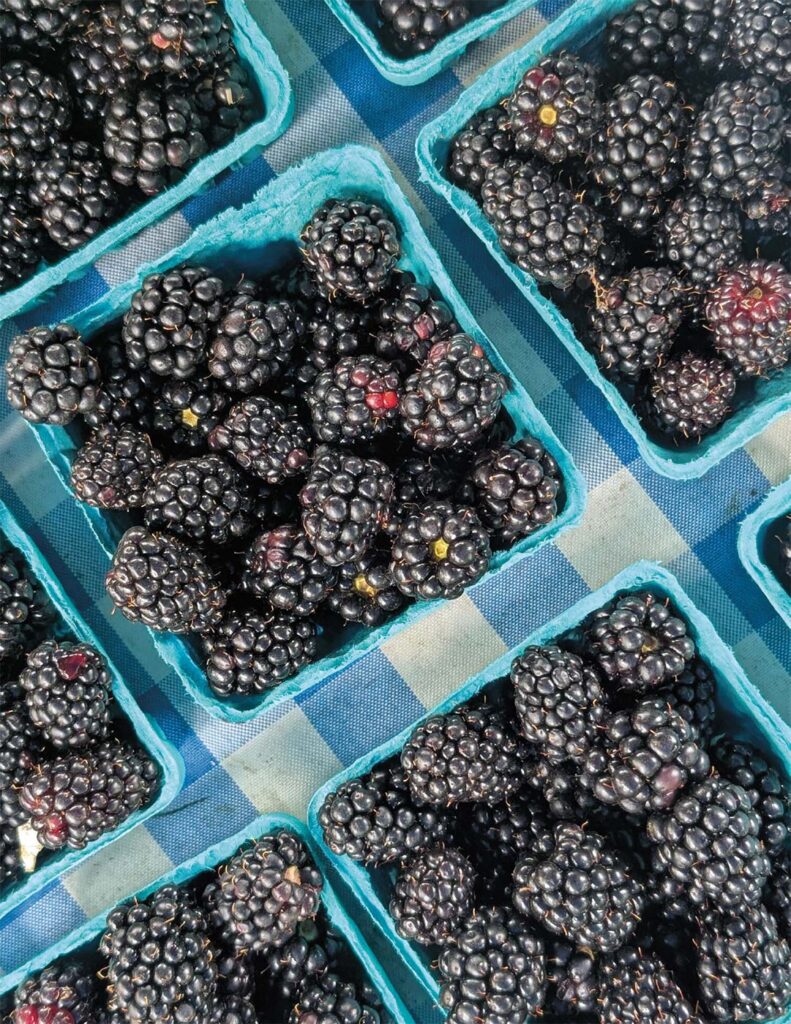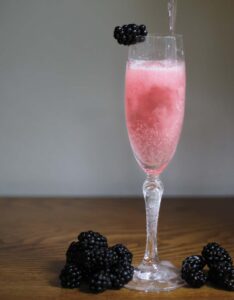
Peak summer happiness hits as Monterey Bay’s blackberries get juicy
PHOTOGRAPHY BY KELLY ROSE EVANS
Summer-ripened blackberries direct from the farmers market belong in a different league than those picked under-ripe and shipped to appear in plastic on grocery store shelves.
The main focus in breeding varieties that must travel long distances is to produce fruit that is large, looks pretty and doesn’t break down quickly, so it can last several weeks before being consumed. It can’t compare to a tender, ripe and sweet blackberry harvested in the sun and sold within a day.
Prevedelli Farms, a family run—since 1945!—certified organic operation in Watsonville, specializes in just that. They cultivate five acres of delectable blackberries and blackberry cultivars including olallieberries, boysenberries and loganberries, harvested at prime ripeness.
Prevedelli, in fact, is one of the only local farms producing these blackberry crosses, partially because they are more fragile and labor intensive to manage due to their thorns and the need to trellis and tie the canes (aka their jointed and thick stems).
Newer varieties can be found thornless as primocanes, which means they have one strong cane, and need minimal trellising, which lowers labor costs.
But growing these tasty, ornery and old-school varieties is a passion worth the hassle at Prevedelli, and their cult following helps reveal why they make the effort.
Let’s get into these interesting cultivars.
Boysenberries are a hybrid between a blackberry, loganberry and raspberry. Boysenberries are very fragile, with a short shelf life, making them hard to find. They are reddish purple and juicy, with a raspberry undertone.
Rudolph Boysen, a Swedish immigrant living in Napa Valley, developed this berry but gave up on growing it after breaking his back in an accident. When he sold his ranch in 1927, he took his plant specimens to Coolidge Rare Plant Gardens in Altadena, where they could be replicated—and not be lost. In fact, Walter Knott of Knott’s Berry Farm in Southern California started successfully growing them in 1934 and he is the reason boysenberries are still around today.
His farm historically hosted a “Taste of Boysenberry Festival” that eventually evolved into an amusement park, and every spring its Boysenberry Festival continues to spotlight 75+ dishes featuring boysenberries.
As a kid living only a few miles from Knott’s Berry Farm, I remember— vividly—indulging in funnel cake with boysenberry preserves on top and drinking boysenberry juice when I would go to the park. After a Saturday night of dancing at Knott’s’ underage goth club, the boysenberry treats in the balmy summer night provided bliss.
The olallieberry is a cross between a black logan blackberry and a youngberry. A youngberry is itself a cross of three different species in the Rubus (or rose) family: raspberry, dewberry and blackberry.
Nick Prevedelli says olallieberries are his favorite and often called “the king of blackberries” because they don’t have as many seeds, and are a little more tart, with a nice balance of sweetness. Their complex flavor profile makes them multipurpose—great eaten fresh, or in pies and jams.
When ripe, they are dark purple and longer than a traditional blackberry. A loganberry, with its own elongated shapes and deep red raspberry colors, started as an accidental cross between a raspberry and blackberry by a Judge James Logan in Santa Cruz in the 1800s. This berry boasts the best of both worlds, with more raspberry flavor than blackberry, but with the size and texture of a blackberry.
May through October, Prevedelli sells delicious fresh berries directly from the family’s Watsonville farm (11am–4pm Fridays at 375 Pioneer View Road), and can be found at the local farmers markets— Del Monte Center in Monterey on Fridays, Cabrillo College in Aptos on Saturdays and Downtown Santa Cruz on Wednesdays.
Their value-added berry products are sold year-round—which include their blackberry jalapeño jam (a great component to a cheese platter or turkey sandwich), their traffic jam (a mix of all the cane berries) and their blackberry margarita mix (great as an addition to your favorite spirit or a mocktail). Their famous blackberry cobbler recipe appears on their website.

HISTORICAL USES
Wild blackberries were a big part of hunter-gatherer diets, including those of Native Americans, and have been eaten for centuries. Evidence to that end was found in the guts of a well-preserved woman discovered in 1835 in a Danish bog, by laborers harvesting peat. This proves that blackberries provided sustenance since at least 500 BC.
Blackberries likely originated from the Northern Hemisphere in temperate areas and spread all over the world with colonization. Planted as a multipurpose crop for edible fruits that could be made into wine, deployed to dye fabric and for use as ink—the berries, leaves and canes all create various colors of purple, pink and gray—and prevent erosion on hillsides.
The vines could be made into strong rope and they were also planted as a barrier of protection against predators and enemies as they are a force once grown into a thicket. However, blackberries do choke out native plants and can become hard to eradicate once established.
HEALTH AND MEDICINAL USES
Historically blackberries were used to cure sore throat and gout, and Romans used the leaves in a tea to help with various ailments like fluid retention, menstrual pain and sore throats. Poultices from the leaves were used to treat wounds and skin issues. The blackberry root may also have been helpful for stomach ulcers and dysentery.
Blackberries are high in antioxidants due to their dark pigment, making them rich in polyphenols, which are healthy, plant-based compounds that reduce inflammation and boost immunity. Blackberries rank one of the highest in polyphenol-rich foods, making them the ultimate source of these protective compounds. They contain a high amount of vitamin C and fiber, too. Medicinally, blackberry leaves can be fermented and used as a digestive support, potentially lowering blood sugar and fighting off oxidative stress and combatting free radicals. They are also a diuretic, flushing toxins from the kidneys.
If you want to make a tea out of blackberry leaves, there is no need to ferment them first, however fermenting does develop beneficial microbes like Lactobacillus and Bifidobacterium species.
WILD BLACKBERRIES
Wild blackberries saved my life—or at least kept me from catastrophic injury.
While riding my bike at Wilder Ranch, my tire got caught in a rut and I went tumbling off the edge of a ravine. I landed upside down, head first in a wild blackberry bramble!
Those wild blackberries prevented me from falling into the beach below and becoming seriously hurt. The vines were so strong, I used them to pull myself upright and climb back up to the top. I was scraped up from the thorns and bleeding, but grateful these invasive wild blackberries held me.
Wild blackberries grow all over this area and can be harvested for fresh eating. Their thorny branches are often intermingled with poison oak, so be aware. Blackberry fruit is green when unripe, red—and tart—when becoming ripe and best picked when sweet and black.
Growing these tasty, ornery and old-school varieties is a passion worth the hassle at Prevedelli, and their cult following helps reveal why they make the effort.
GROWING YOUR OWN
Blackberries can spread like their wild cousins, so be careful where you plant them in your garden. Personally, I would keep them in wine barrels or large pots to keep them contained.
They need full sun and like soil to be moist, but well-drained. Blackberries enjoy a slightly acidic soil and do well with the addition of compost and a fertilizer that has an equal mix of nitrogen, potassium and phosphorus. You will need to stake them to help them grow upright, or plant them next to something they can lean on for support.
Blackberries also won’t fruit until the second year. Once they are finished fruiting, it is important to prune them back so they can regrow and fruit again. Birds are the biggest problem in cane berries; Prevedelli Farms uses plastic hawks and silver steamers that move in the wind to deter birds. However, birds still eat about 10% of the crop if it isn’t netted. Keeping bees or encouraging them where you are growing cane berries will help them set more fruit.
Spotted-wing drosophila can be a major pest in blackberries and blackberry cultivars. They are fruit flies that lay eggs under the skin of the fresh fruit. The larvae hatch in the fruit and the fruit ends up decaying rapidly. One way to control this pest is to harvest ripe fruit consistently and do not leave fruit to get over-ripe or rot nearby. If you don’t want to grow your own, Live Earth Farm in Watsonville has a seasonal, organic blackberry u-pick. Check their website for updates, liveearthfarm.net.
EATING AND STORING BLACKBERRIES
If you do pick up blackberries that are not yet soft and ready to eat, I suggest keeping them on your kitchen counter and letting them ripen, and eating the ones that are a bit soft first while letting the others take time to sweeten up. Savory preparations with berries are some of my favorites.
I really enjoy putting blackberries in a salad along with some red onion and feta or soft goat cheese, and some steak or tri-tip. Toss a few blackberries in the blender with some olive oil and a balsamic reduction to pour over the salad.
Reducing blackberries with herbs like rosemary and thyme and a little sugar can make a really great addition to meat dishes like pork chops, pulled pork sliders and roasted chicken. How about adding them to a brie grilled cheese, or topping a homemade pizza with blackberries, ricotta cheese and basil?
Be sure to get to the farmers market this summer to support your local growers and load up on local blackberries before they are gone, which happens faster than I’d wish.

About the author
Jamie Collins is the owner of Serendipity Farms and has been growing organic row crops at the mouth of Carmel Valley since 2001. She distributes her produce through a CSA, u-picks and farmers’ markets.
- Jamie Collinshttps://www.ediblemontereybay.com/author/jcollins/
- Jamie Collinshttps://www.ediblemontereybay.com/author/jcollins/
- Jamie Collinshttps://www.ediblemontereybay.com/author/jcollins/
- Jamie Collinshttps://www.ediblemontereybay.com/author/jcollins/



